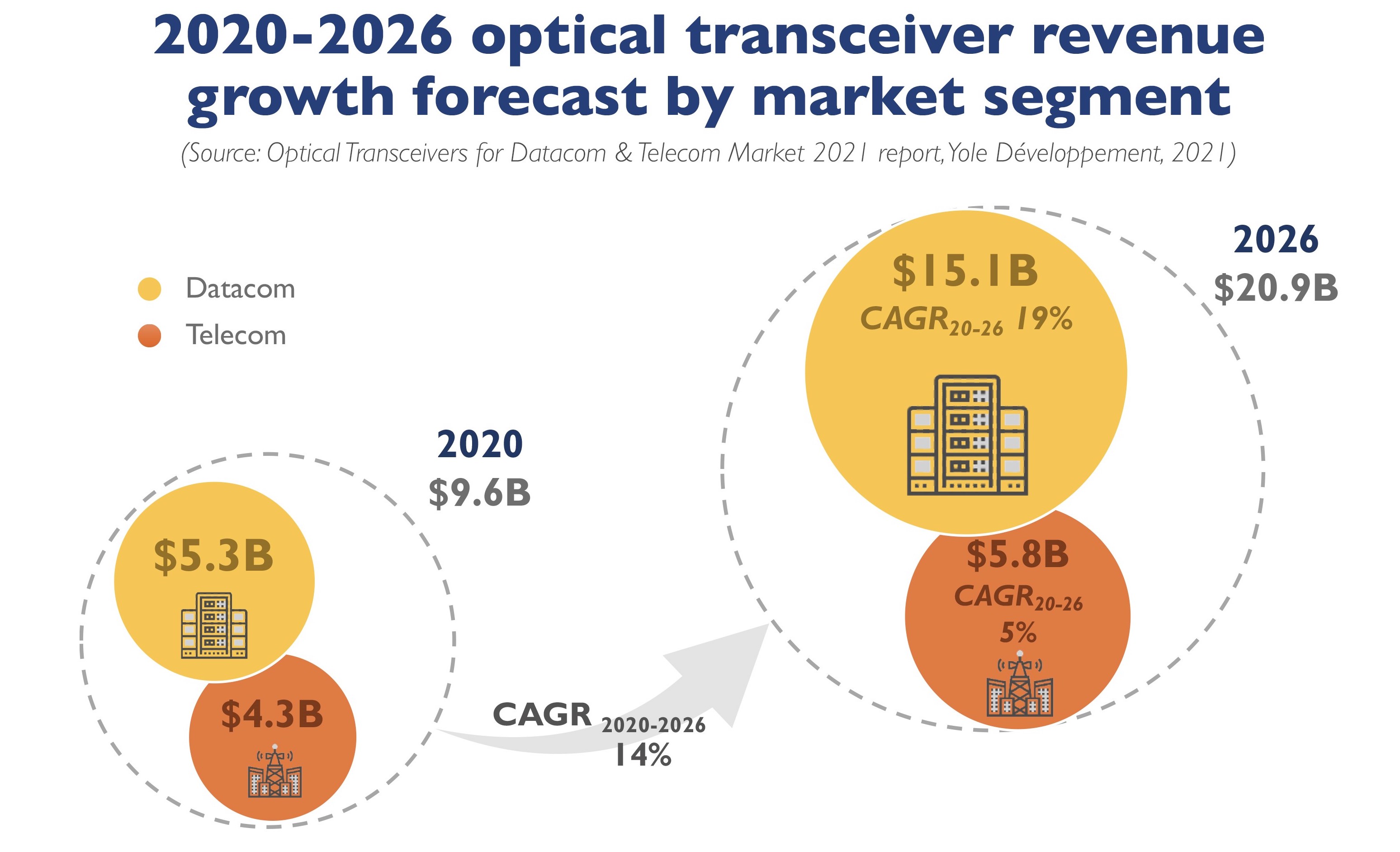Optical transceiver market to grow 14% in next five years

Yole predicts growing popularity of 800G modules as they take advantage of 100G single-wavelength optics already proven in 400GbE systems
According to Yole Développement's Optical Transceivers for Datacom & Telecom Market 2021 report, revenue generated by optical transceiver market is expected to grow from $9.6 billion in 2020 to $20.9 billion in 2026, at a CAGR for 2021-2026 of 14 percent. This growth is driven by high data rate modules above 100G, big cloud service and national telecom operators.
While COVID-19 has affected manufacturing globally, the optical transceivers industry has nevetheless grown by 24 percent in China the last three years, while only by 1 percent in the US.
“For the past 50 years, mobile technology innovations have been rolled out each decade”, says Martin Vallo, technology & market analyst, Solid-state Lighting at Yole Développement (Yole). He adds:“Mobile bandwidth requirements have evolved from voice calls and texting to UHD video and a variety of AR/VR applications. In spite of deep implications of the COVID-19 outbreak for the telecom infrastructure supply chain, consumers and business users worldwide continue to create new demand for networking and cloud services. Social networking, business meetings, video streaming in UHD, e-commerce and gaming will drive the continued application growth”.
The average number of devices connected to the internet per household and per capita is increasing. Expanding machine-to-machine applications, such as smart meters, video surveillance, healthcare monitoring, connected drives, and automated logistics, contribute in a major way to device and connection growth and push the expansion of data centre infrastructure.
Three material platforms are used in today’s optical transceivers: GaAs, InP and SiPh. Today’s challenges are to reduce size, and decrease power consumption while increasing data throughput.
The evolution of multiple technologies has enabled data rates of 400G, 600G, 800G and beyond across data centre infrastructure as well as in long-haul and metro networks. 400GbE deployments are ramping across data centre networks. Many cloud providers and telecom operators are now looking to 800Gbps optical ecosystem to increase bandwidth capacity and keep pace with the growing demand for data. 800G optical modules can support more configurations, for example 2x 400GbE, 4x 200GbE or 8x 100GbE.
Today’s Ethernet switch ASICs are running at a 50Gbps lane rate driven by 50G PAM-4 modulation technology. In line cards, a re-timer is typically needed to synchronize PAM-4 data from the switch to the optical interface. In 400G optical modules, an additional silicon gearbox chip can be used to convert 50G PAM-4 electrical I/Os to 100G per wavelength optical I/Os in order to connect to 100G optics. Depending on the application and transmission reach 400G offer various optical interfaces, including 400G SR4, 400G DR4, 400G FR4 and 400G LR4.
According to Pars Mukish, business unit manager, Solid-State Lighting & Display at Yole: “We anticipate high popularity of 800G modules as they take advantage of 100G single-wavelength optics already proven in 400GbE systems and thus can be technically and cost-effectively implemented in QSFP-DD and OSFP form factors”.
Current form factors will be limited in their ability to support more than 800G capacity in terms of required electrical and optical densities and thermal aspects. Power consumption is another challenge. The largest contributor is the electrical interface between the switch ASIC and optical module, particularly for QSFP-DD and OSFP. As a result of discrete electrical device implementation power dissipation and thermal management are becoming limiting factors for future pluggable optics.
For Sylvain Hallereau, principal technology & cost analyst at System Plus Consulting: “InnoLight's 400G QSFP-DD is one of the first 400G optical transceivers on the market, allowing communication up to 2km using PSM4 modulation. The InnoLight solution is based on the IN010C50 PAM4 DSP chipset, four GaAs laser driver dies, and a TIA die, all designed by Inphi”.
Co packaged optics (CPO) is a new approach that brings the optics and the switch ASIC close together and aims to overcome challenges mentioned above. Furthermore, CPO technology is considered as a new deployment model of the whole ecosystem and alternative to the pluggable optics.


































